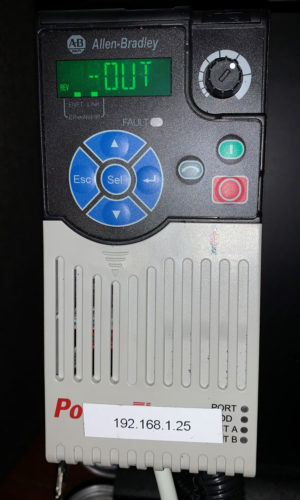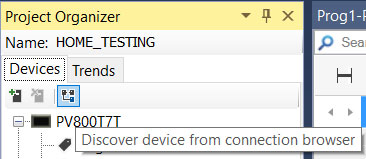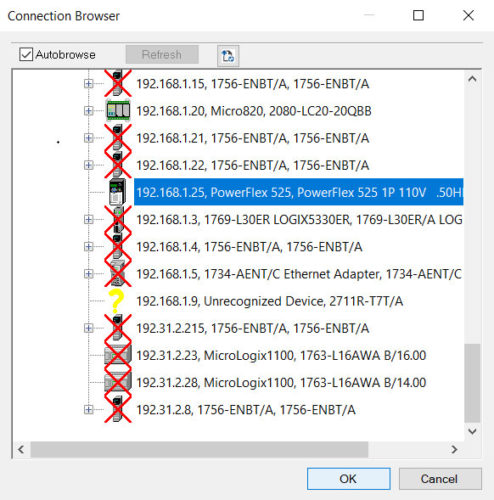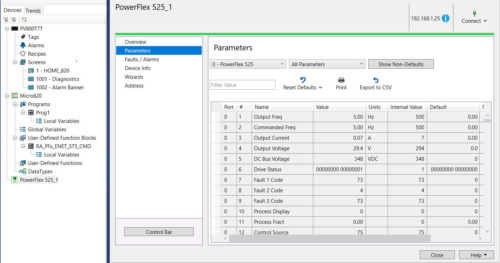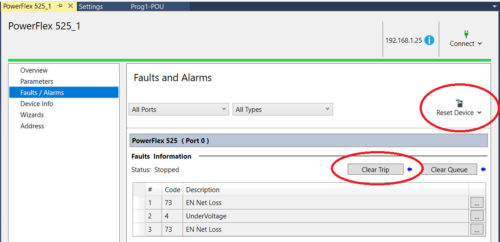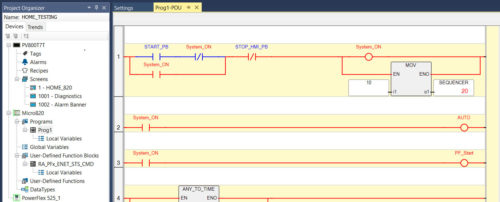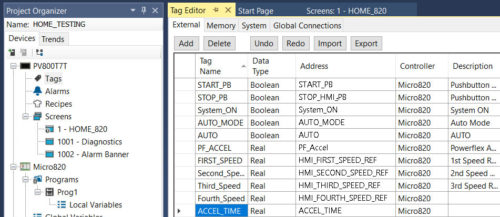
One of the positive attributes of the Connected Components Workbench project is the ability to program multiple devices with one software package.
A CCW project can contain the Panelview 800 HMI, the Micro 800 controller and as we will see today, a Powerflex drive.
This makes configuration simple and provides quick access between devices that need to work together for a successful project.
Powerflex 525
Here, I have a PowerFlex 525 drive that I wish to add to my CCW project. The drive has an IP address of 192.168.1.25 and I connect it to my Ethernet network to communicate with my PanelView 800 HMI and Micro 820 controller:
Adding the PF 525 to the CCW Project
As with adding the Micro820 controller, we can select the “Discover Device from connection browser” and select the PowerFlex drive by browsing to it in RSLinx:
Select “OK” to connect to the Drive in the CCW project, and then on the Drive Overview Tab, click the “Add to Project” button.
Now on the left you will see several selections including Parameters, Faults/Alarms, Device Info, Wizards and Address Information
With Parameters selected, you’ll see the drive parameters as shown below:
With Drive Faults selected, you can view the drive faults as well as perform fault resets. By clicking the “Clear Trip” button, I can clear a PowerFlex drive fault. And by clicking the “Reset Device” button, I can completely reboot the PowerFlex drive.
Micro820 – Ladder Code
In today’s example, the PV800 HMI, the Micro820, and the PowerFlex 525 are used together to allow an operator to control the running a motor.

The operator will interact with the HMI, which communicates to a controller that has the interlocks and programming needed to control the Drive, which in turn controls the motor speed and provides protection for both the Drive and Motor.
PV 800 HMI
So that the PV800 can interact with the Micro820, we need to create tags that communicate with the commands and feedback signals for the Drive that are in the Micro820 controller.
In my example, I entered the following tags in the PV800 project tag database to connect to the Micro820 controller.
Next, I created a screen called HOME_820 with a few pushbuttons and numeric displays to interact with the drive and view the feedback data.
The first numeric display shown below has a “Read Tag” connection of “FIRST_SPEED” which is the first drive speed that will run during its sequence.
Next, this pushbutton has an “Indicator Tag” (System_ON) to create animation of the button (change colors and text) and a “Write Tag” (STOP_PB) to write a command to the Micro 820 controller.
TIP: You can Double-Click on an object to bring up the color changes, text and animation properties, however the “Tag” properties as well as other object properties are in the “Properties” window on the right side of the CCW project window.
The final step is to validate, download and test our PV800 and Micro820 programs.
Runtime
The rewarding part is when it all comes together. You interact from HMI to controller to drive/motor running and it displays for you to see.
Conclusion
Here we took a high-level overview of everything from having the HMI, controller and a drive connected together in our CCW project, adding the drive to the project and a look at parameters and interaction with the drive. Then a little HMI and programming work to make it all come together.
I hope you were able to pick up something today to help you make your next project a success.
Written by Brandon Cooper
Senior Controls Engineer and Freelance Writer
Have a question? Join our community of pros to take part in the discussion! You'll also find all of our automation courses at TheAutomationSchool.com.
Sponsor and Advertise: Get your product or service in front of our 75K followers while also supporting independent automation journalism by sponsoring or advertising with us! Learn more in our Media Guide here, or contact us using this form.
- Things I’ve Learned Travelling for Work (2) - July 17, 2025
- Things I’ve Learned Travelling for Work (1) - July 10, 2025
- Emulating an Allen-Bradley E3 or E3 Plus - June 30, 2025

Discover more from The Automation Blog
Subscribe to get the latest posts sent to your email.



